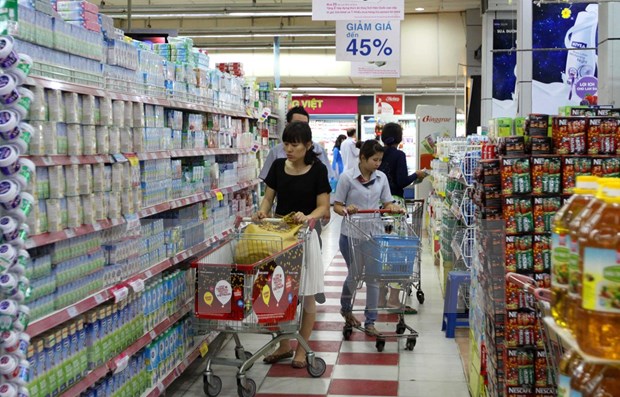Price increases drive July CPI up 0.18 percent
 Illustrative image (Source: VNA)
Illustrative image (Source: VNA)
Hanoi (VNA) - The national consumer price index (CPI) in July grew 0.18 percent from the previous month and 2.44 percent year-on-year, the General Statistics Office (GSO) released on July 29.
The average CPI rose 2.61 percent on-year between January and July, the lowest growth for a seven-month period over the past three years.
Nine out of eleven commodity groups experience price rises
Director of the GSO’s Price Statistics Department Do Thi Ngoc said the rise in July’s CPI was fuelled by high prices of food, especially pork, which swelled 0.81 percent from the previous month.
Among the 11 main commodity groups, nine experienced price rises, including goods and other services with the highest rise of 0.94 percent; food and catering services (0.33 percent); education (0.22 percent); culture, entertainment and tourism (0.15 percent), beverage and tobacco (0.12 percent).
The prices of transportation; housing, electricity, water and construction materials saw the same price drop of 0.03 percent.
Director of the GSO’s Price Statistics Department Do Thi Ngoc attributed the price rise partly to the spread of African swine fever in 62 cities and provinces nationwide (except for Ninh Thuan central province). Specifically, 3.7 million pigs had been culled due to the disease as of July 24, causing pork prices to rise 0.81 percent and CPI 0.03 percent against the previous month.
In addition, the petrol price was up 0.04 percent compared to June, resulting in a 0.002 percent rise of the CPI of this good in July.
Meanwhile, the CPI of the health insurance group in July increased 6.67 percent month-on-month due to the increase of basic salary.
There was an increase in the tuition fees in some provinces and central-level cities under a Government Decree.


US dollar price index down, gold price up
The price of US dollar in the world market decreased in July as a result of numerous forecasts on US Federal Reserve System’s interest cut to stimulate the US economic growth.
However, strong foreign reserves in Vietnam kept the VND/USD exchange rate stabilized. The greenback declined by some 0.56 percent against the Vietnam dong, while the dollar price on the unofficial market was roughly 23,220VND, Director of the GSO’s Price Statistics Department Do ThiNgoc added.
During the month, the domestic gold price was about 39.7 million VND per tael, 4.78 percent higher than the previous month, driven by the 4.04 percent rise in the global price.
According to the GSO, core inflation (CPI exclusive of foodstuff, fresh food, energy, healthcare and education services) in July and the first seven months of 2019 increased by 0.23 percent and 1.89 percent, respectively, compared with the same period last year.
During the month, the domestic gold price was around 3.97 millionVND (171.06 USD) per tael, 4.78 percent higher than the previous month.
GDP in first half highest in nine years
Vietnam’s gross domestic product (GDP) grew 6.76 percent in the first half of this year, the second highest rate since 2011.
The growth was fuelled by a stable macro-economy, impressive rice exports, declining unemployment rate, and robust economic production.
The processing and manufacturing sector remained the pillar of GDP growth, posting a growth of over 11 per cent, lower than the same period last year but much higher than that in the first halves of 2012-2017.
The agro-forestry-fishery sector expanded nearly 2.4 per cent, contributing 6 per cent to GDP growth.
Meanwhile, the service industry was backed by rosy wholesale and retail sales, financial activities, banking and insurance, transportation and warehouses.
The Vietnamese economy had shown positive signs, with business confidence remaining high among domestic and foreign investors in the period.
According to Nikkei report, the Việt Nam Manufacturing Purchasing Managers’ Index (PMI) stood at 52 points, which is higher than regional countries. Producers believed that customer demand improved, and there were rises in new orders both from domestic and overseas clients.
A survey conducted by the GSO in Q2 showed that most businesses had good business results, and felt upbeat about the situation in Q3./.











